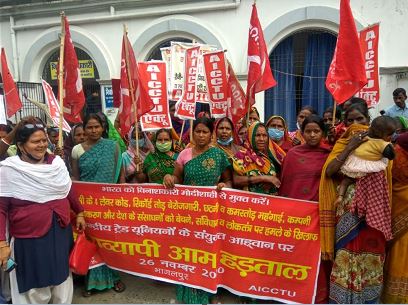On Thursday, India witnessed perhaps the world’s largest ever labour strike. Between 200 and 250 million workers walked off the job and into the streets across the country.
The massive strike was organised by India’s largest national-level union federations. The platform included Indian National Trade Union Congress, All India Trade Union Congress, Hind Mazdoor Sabha, Centre of Indian Trade Unions, All India United Trade Union Centre, Trade Union Co-ordination Centre and Self-Employed Women’s Association. Several states were entirely shut down due to the strikes, and disruptions were seen and felt across India.
Strikers were predominantly made up of farmers and rural workers, but also included miners, domestic laborers, beedi (tobacco) workers, railway workers, bus and taxi drivers, cooks, banking employees, steel and copper factory workers, stevedores and construction workers.
The massive protests are a response to a lack of government support during the coronavirus pandemic, topped off by Prime Minister Narendra Modi’s attempt to “reform” labour laws. Modi has claimed current laws disincentivise labour-intensive production, and his recent legislative changes aim to facilitate privatization of state assets and make it easier for large enterprises to fire large numbers of workers at one time.
Protesters want Modi’s farm and labour laws to be scrapped. They’re calling for an end to exploitative day-labouring hires, permanent contracts and a monthly minimum wage of A$330. They are also are calling for the immediate transfer of AUD $135 to all poor families, as well as a monthly 10kg rice ration.

India operated under strict coronavirus regulations from late March until August, and continues to face restrictions on certain activities. The country has seen at least 9.3 million confirmed cases, although the actual number of infections is sure to be far higher.
India’s rising national income and expanding middle-classes are often celebrated in international media. Yet India’s minimum wage workers are still earning less than A$5 per day.
Of course, First World media outlets have by and large supported Modi’s pro-capital position and minimised the massive popular opposition they have generated.
Reuters cited an Indian business chamber spokesperson saying the changes are “bound to create more attraction for foreign investments in small-scale sectors.” They also foregrounded a Washington-based think-tank, which argued that “India’s stifling labor regulations [are] a key deterrent to making larger investments.”
Yes, that’s right. Apparently the big problem for Indian workers is that they have too much job security and earn too much money!